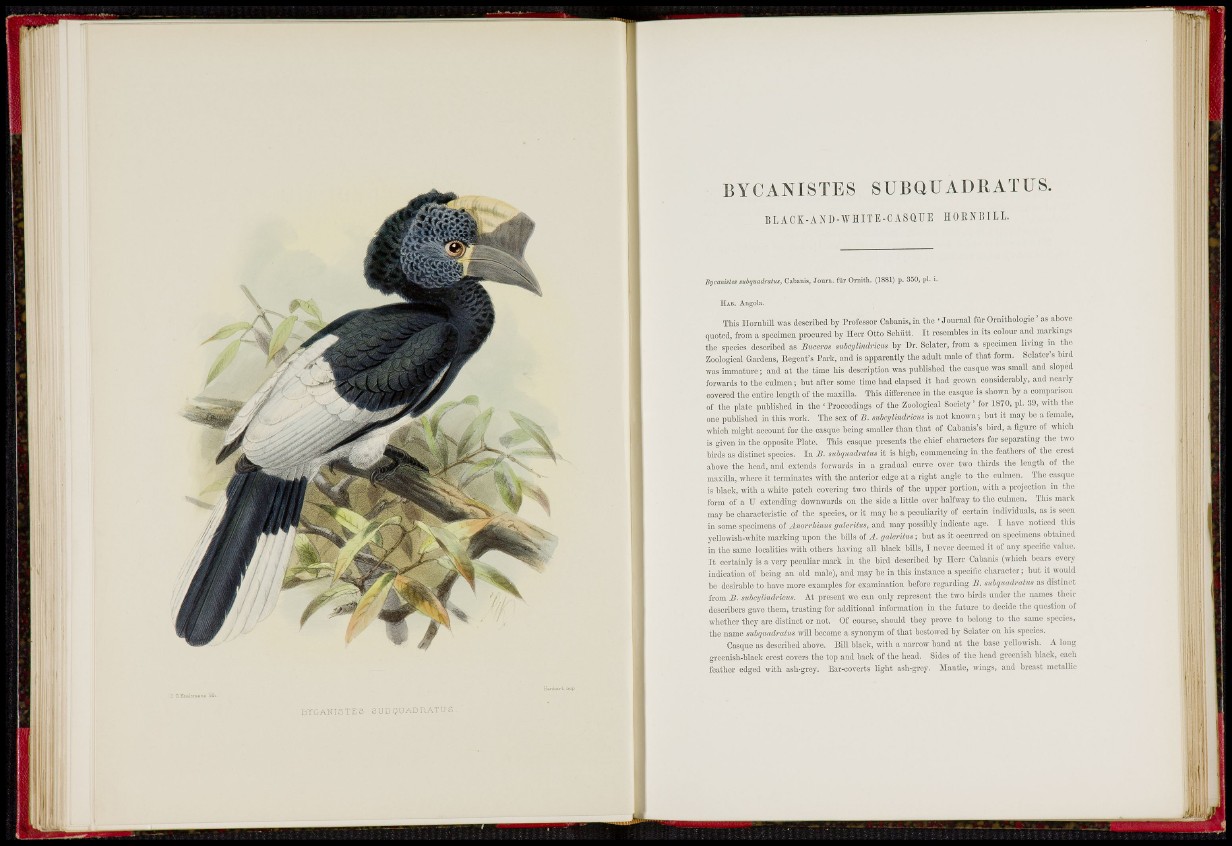
BYGANISTE5 SUB QUADRATH S .
BYCANISTES SUBQUADllATUS.
B L A C K - A X D - W n i T E - C A S Q U E nOllNEILL.
Hycanistee subquadraius, Cabania, Jouru. fdr Omith. (1881) p. 350, pi. i.
HAB. Angola.
This Hombill ivas doscribed by Professor Cabonis, m tlio ' Journal für Ornitliologic ' as above
quoted, from a spooimott procured by Herr Otto Sebfflt. It resembles in its colour and markings
tlio species described as Bucera mticjUndrkm by Dr. Selater, from a specimen liring in the
Zoolosioal Gardens, Eegent's Pai-k, and is apparently the adult male of tliat form. Solater's tard
was immature ; and at tiro time his description was published the casque was small and sloped
forwards to the ouhnen; but after some time had elapsed it had grown considerably, and nearly
cOTered the entire length of the maxilla. This diifercnco in the casque is shown liy a comparison
of the plate pnblislied in the • Proceedings of the Zoological Society' for 1870, pi. 39, with tho
one published in this »-ork. The scI of 13. mbcylindricm is not known ; but it may be a female,
which might account for the casque being smaller than that of Cabanis's bird, a figure ot which
is given in tlie opposite Plate. This casque presents tho chief characters for separating the two
bii°ds as distinct species. In B. mhqua.dra,tm it is high, commencing in the feathers of the crest
above the head, and extends forwards in a gradual curve oyer two thirds the length of the
maxilla, wliore it terminates with the anterior edge at a right angle to the culmen. ïlie casque
is black, with a white patch covering two thirds of the upper portion, with a projection in the
form of a TJ extending downwards on tho side a little over halfway to the crdmen. This mark
may be characteristic of the specics, or it may be a peculiarity of certain individuals, as is seen
in some specimens of Anorrhinus galeriius, and may possibly indieatc age. I have noticed this
yellowish-white mar-king upon tho bills ot A. <j<aerUus ; but as it occnrrcd on spceimens obtained
in tho same localities with others having all black bills, I never deemed it of any specific value.
I t certainly is a very pecnliat mark in the bird described by Herr Oabanis (wliieh bears every
indication of being an old male), and may be in this instance a specilic character ; but it would
be desirable to have more examples for examination before regarding li. mbquadnlun as distinct
from JÎ. auieylmdrictts. At present we can only represent the two birds under the names their
dcscribers gave them, trustmg for additional information in the future to decide the question of
whether they arc distinct or not. Of course, should they prove to belong to the same species,
the name subquadratm will become a synonym of that bestowed by Sclater on his species.
Casque as deseribed above. Bill black, with a narrow band at the base yellowish. A long
grccnish-blaek crcst covers the top and back of the head. Sides of the head greenish black, each
feather edged with ash-grey. Eai-eovorts Ught ash-grey. Hantle, wings, and breast metallic